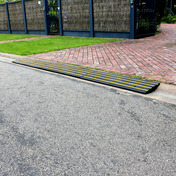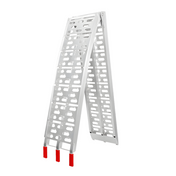So you’re ready to upgrade your ramp.
Maybe your current setup is aging, or perhaps you’re looking to future-proof your business operations with the latest designs.
Either way, the ramp industry is gearing up for a major leap forward in 2026.
From modular designs to smart sensors and sustainable materials, innovation is redefining how Australians load, transport, and work safely every day.
Let’s explore the biggest custom ramps trends shaping 2026, and what they mean for your business, vehicles, and access needs.
What Are the Latest Custom Ramp Innovations Expected in 2026?
Innovation in ramp design is going beyond weight and strength. It’s about intelligence, adaptability, and ease of use.
You might think a ramp is just a ramp, but 2026 might surprise you. The latest innovations aren’t just about making ramps lighter or stronger; they’re about making them smarter and more adaptable to different applications.
Here’s what’s leading the charge:
Modular Design for Versatility

One-size-fits-all is a thing of the past. In 2026, ramps will feature modular sections that can be adjusted for different vehicles, load types, or site conditions — especially useful for those using both UTE loading ramps and trailer ramps.
| Pros: | Cons: |
|
|
Smart Hydraulics and Automation

Press a button. Let the ramp work for you.
Hydraulic-assisted ramps are becoming more common across warehouses and loading bays in Australia, helping operators raise and lower platforms with less effort.
In 2026, smarter control systems will make this even more efficient.
| Pros: | Cons: |
|
|
Custom Engineering for Aussie Conditions
 Australia’s environment demands strength. From intense heat to salty coastal air, ramps need to handle it all. Manufacturers are responding with marine-grade aluminium folding loading ramps that are ideal for outdoor work, built to withstand the elements.
Australia’s environment demands strength. From intense heat to salty coastal air, ramps need to handle it all. Manufacturers are responding with marine-grade aluminium folding loading ramps that are ideal for outdoor work, built to withstand the elements.
| Pros: | Cons: |
|
|
What Styles and Materials Will Define Custom Ramps in 2026?
You might not think of ramps as “stylish,” but the truth is design matters. In 2026, form and function are working hand-in-hand. The focus? Building ramps that don’t just perform, but also look sharp, align with brand identity, and promote safety through visual design.
Aluminium: The Lightweight Powerhouse
Aluminium ramps remain the top choice for many buyers. In 2026, expect refined high-grade alloys that deliver strength, portability, and rust resistance, ideal for UTE ramps or mobile loading.
| Pros: | Cons: |
|
|
Steel: The Heavy-Duty Classic

For trades and heavy-equipment operators, steel stays unbeatable. Enhanced with powder-coated finishes and reinforced welds, these ramps offer unmatched strength and longevity.
| Pros: | Cons: |
|
|
Composite & Eco-Friendly Materials

Sustainability is shaping ramp designs. Expect more ramps made from recycled rubber, fibreglass, and resin composites, offering strength with less environmental impact.
| Pros: | Cons: |
|
|
Custom Finishes and Branding

Australian businesses are adding a personal touch to their ramps with colour-coded edges, anti-slip coatings in corporate colours, and laser-etched logos. These features aren’t just for looks but enhance both safety and brand visibility.
| Pros: | Cons: |
|
|
What New Safety Features Are Being Introduced in Custom Ramp Designs for 2026?

Innovation isn’t just about looks—2026 ramps are raising the bar for safety.
Non-Slip Surfaces and Edge Guards
Laser-cut or machined patterns offer better traction in wet or oily conditions. Raised edges help keep tyres and trolleys on track.
| Pros: | Cons: |
|
|
Load Monitoring & Smart Sensors

Smart ramps are on the rise. Built-in sensors will detect when weight limits are close to capacity, helping operators stay within safe limits. While still emerging in portable models, 2026 may bring wider use of digital load monitoring and alerts to prevent overloading.
| Pros: | Cons: |
|
|
Compliance with Australian Standards

Australian manufacturers are putting a stronger focus on meeting and exceeding standards like AS 1428.1 for access ramps, AS/NZS 1664 for aluminium structures, and AS/NZS 4100 for steel designs. This ensures safety, reliability, and legal compliance.
| Pros: | Cons: |
|
|
How to Choose the Right Custom Ramp for Your Business in 2026
With so many innovations on the way, choosing the right ramp comes down to fit and function.
Use this quick checklist to guide you:
1. Identify what you’ll use it for.
Are you loading vehicles, machinery, or goods? Your ramp type depends on your primary task.
2. Know your weight requirements.
Match the ramp’s load capacity to your heaviest expected load, not the average.
3. Consider your materials and conditions.
Aluminium suits mobility and light work, while steel is suited for heavy-duty use. For sustainability, look into composite materials.
4. Factor in safety features.
Non-slip surfaces, side rails, and smart sensors aren’t extras anymore; they’re essentials for compliance and peace of mind.
5. Think long-term value.
The cheapest ramp isn’t always the best investment. Quality ramps last longer, perform better, and keep your team safe.
The Future of Custom Ramps in Australia

As 2026 approaches, ramp design is entering a new era of smart, safe and sustainable innovation.
From modular systems and advanced safety technology to custom finishes and Australian-standard compliance, the ramps of tomorrow will deliver more than support your operations; they’ll enhance them.
At Ramp Champ, we’re proud to be part of that progress. We’ve been helping Australian businesses find the right ramp solutions since 2016. As innovations evolve, we’ll continue to deliver ramps that are built tough, designed smart, and tailored for your needs.
Future-proof your operations with a ramp built for Australia’s toughest conditions.
Our team can help you design, quote, and source the perfect solution built for your business and Australia’s toughest conditions.






